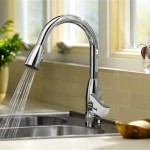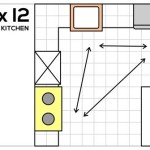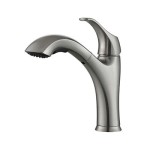```html
Kitchen Sink Faucet Single Handle: A Comprehensive Guide
The kitchen sink faucet, particularly the single-handle variant, is a critical component of any modern kitchen. Its functionality and design influence both the efficiency of kitchen tasks and the overall aesthetic appeal of the space. Understanding the nuances of single-handle kitchen sink faucets is crucial for homeowners seeking to upgrade their existing fixtures or for those planning a new kitchen build. This article provides a detailed overview of single-handle kitchen sink faucets, covering their mechanisms, advantages, types, installation process, common issues, and maintenance tips.
Understanding the Mechanics of a Single Handle Faucet
Single-handle kitchen sink faucets operate on a relatively simple yet ingenious principle. Unlike traditional two-handle faucets that require independent control for hot and cold water, a single-handle faucet combines both functionalities into a single lever. This lever controls the flow and temperature of the water through a combination of internal components, primarily a cartridge or a ceramic disc.
Inside the faucet body, the handle is connected to the cartridge or ceramic disc. When the handle is moved up or down, it regulates the water flow. Tilting the handle left or right adjusts the mixture of hot and cold water, thereby controlling the temperature. The cartridge or ceramic disc contains precisely engineered openings that align to allow water to flow through when the handle is in the open position. The degree of alignment dictates the volume and temperature of the water delivered. This design allows for precise and effortless control with a single hand, a significant advantage in busy kitchen environments.
Cartridges are typically made of plastic or brass and contain rubber or synthetic seals that control the water flow. Over time, these seals can wear down, leading to drips or leaks. Ceramic disc faucets, on the other hand, utilize two ceramic discs with precisely polished surfaces that slide against each other. The accuracy of these surfaces ensures a tight seal, providing greater durability and leak resistance compared to cartridge-based faucets. While ceramic disc faucets often come with a higher initial cost, their longevity and reduced maintenance requirements often make them a cost-effective choice in the long run.
Advantages of Single Handle Kitchen Sink Faucets
Single-handle kitchen sink faucets offer numerous advantages over their two-handle counterparts, making them a popular choice for modern kitchens. These benefits extend beyond mere convenience and encompass factors such as water conservation, ease of use, and aesthetic appeal.
One of the primary advantages is ease of use. The single handle allows for effortless control of both water flow and temperature with just one hand. This is particularly useful when one hand is occupied with food preparation or cleaning. The simplicity of the design also makes it easier for individuals with limited dexterity or mobility to operate the faucet comfortably.
Furthermore, single-handle faucets can contribute to water conservation. The user can quickly and easily adjust the temperature and flow to the desired level without wasting water while searching for the perfect balance between hot and cold. This is especially beneficial in households with water conservation as a priority. Some single-handle faucets are also equipped with flow restrictors or aerators, which further reduce water consumption without compromising water pressure.
Aesthetically, single-handle faucets often boast a sleek and modern design that complements a wide range of kitchen styles. Their minimalist appearance can contribute to a cleaner and more streamlined look in the kitchen. They are available in various finishes, including chrome, stainless steel, bronze, and matte black, allowing homeowners to select a faucet that seamlessly integrates with their existing décor.
Finally, installation can often be simpler with single-handle faucets compared to dual-handle options. The reduced number of connections and components can streamline the installation process, making it a viable DIY project for some homeowners. However, it is always recommended to consult a qualified plumber if you are unsure about any aspect of the installation.
Types of Single Handle Kitchen Sink Faucets
Within the category of single-handle kitchen sink faucets, there is a variety of types to choose from, each offering unique features and benefits. Understanding these types can help homeowners select the faucet that best suits their specific needs and preferences.
One common type is the pull-down faucet. These faucets feature a spray head that can be pulled down from the spout, providing extended reach and flexibility for rinsing dishes or cleaning the sink. The pull-down hose is typically weighted to ensure that the spray head retracts smoothly and securely back into the spout. These are excellent for larger sinks or those who frequently wash large pots and pans.
Pull-out faucets are similar to pull-down faucets, but the spray head pulls out horizontally rather than vertically. This design can be preferable for some users, providing a more natural angle for spraying and rinsing. Pull-out faucets are also often more compact than pull-down faucets, making them a good choice for smaller kitchens.
Bar faucets, also known as prep faucets, are smaller versions of kitchen faucets that are typically installed in a separate bar sink or prep area. These faucets usually have a shorter spout and a more compact design, making them ideal for smaller spaces. They provide the same functionality as a full-size kitchen faucet but in a more convenient and space-saving format.
Touchless faucets are a relatively recent innovation in kitchen faucet technology. These faucets use sensors to detect hand movements, allowing users to turn the water on and off without physically touching the handle. This feature can be particularly beneficial in preventing the spread of germs and bacteria, and it also helps to conserve water by preventing the faucet from running unnecessarily. These faucets often require a power source, either batteries or a dedicated electrical outlet.
Bridge faucets have a distinctive design featuring two separate handles connected by a horizontal bar. While technically not single-handle faucets, some modern iterations incorporate a single lever to control both temperature and flow. These faucets often evoke a vintage or traditional aesthetic and can add a touch of elegance to the kitchen. Their unique design requires specific installation considerations.
Installation Process for a Single Handle Kitchen Sink Faucet
Installing a single-handle kitchen sink faucet is a manageable DIY project for homeowners with some plumbing experience. However, it is crucial to follow the instructions carefully and take necessary safety precautions to avoid any potential problems. If you are unsure about any aspect of the installation, it is always best to consult a qualified plumber.
The first step is to gather the necessary tools and materials. These typically include a basin wrench, adjustable wrench, screwdriver, plumber's tape, supply lines, and the new faucet itself. It is also essential to turn off the water supply to the sink before starting the installation. Locate the shut-off valves under the sink and turn them clockwise to shut off the water flow. Place a bucket under the existing faucet to catch any residual water.
Next, disconnect the old faucet. Use the basin wrench to loosen the nuts connecting the supply lines to the faucet. Disconnect the sprayer hose, if applicable. Once all the connections are loosened, carefully remove the old faucet from the sink. Clean the sink surface thoroughly to remove any debris or old sealant.
Install the new faucet according to the manufacturer's instructions. Usually, this involves inserting the faucet body through the sinkhole and securing it with mounting hardware from underneath the sink. Apply plumber's tape to the threads of the water supply connections to ensure a watertight seal. Connect the supply lines to the faucet, tightening the nuts securely with an adjustable wrench. Connect the sprayer hose, if applicable.
Once all the connections are made, turn the water supply back on slowly and check for leaks. If you find any leaks, tighten the connections further or reapply plumber's tape. Ensure the faucet is functioning correctly by testing the water flow and temperature. If necessary, refer to the manufacturer's instructions for any adjustments or troubleshooting tips. Dispose of the old faucet and any discarded materials properly.
Common Issues and Troubleshooting
Even with proper installation and maintenance, single-handle kitchen sink faucets can experience certain issues over time. Recognizing these common problems and knowing how to troubleshoot them can save homeowners time and money on repairs.
One of the most frequent issues is dripping. Dripping faucets are usually caused by a worn-out or damaged cartridge or ceramic disc. Replacing the cartridge or ceramic disc is typically a straightforward repair that can be done with basic tools. Start by turning off the water supply and disassembling the faucet to access the cartridge or disc. Replace the old part with a new one, ensuring it is properly seated. Reassemble the faucet and turn the water supply back on to check if the dripping has stopped.
Another common problem is reduced water flow. This can be caused by mineral buildup or debris clogging the aerator or the faucet body. To clean the aerator, unscrew it from the faucet spout and soak it in vinegar to dissolve any mineral deposits. Rinse the aerator thoroughly and reattach it to the faucet. If the problem persists, you may need to disassemble the faucet to clean the internal components.
A loose handle can also be a source of frustration. This is often due to a loose screw or nut that secures the handle to the faucet body. Locate the screw or nut and tighten it with a screwdriver or wrench. If the screw is stripped, you may need to replace it with a new one.
Water leaking from the base of the faucet can indicate a problem with the O-rings or seals between the faucet body and the sink. Replacing these O-rings or seals can usually resolve the issue. Turn off the water supply, disconnect the faucet, and replace the worn-out seals with new ones. Reinstall the faucet and check for leaks.
Maintenance Tips for Longevity
Proper maintenance is crucial for extending the lifespan of a single-handle kitchen sink faucet and ensuring its optimal performance. Implementing a few simple maintenance practices can prevent common issues and keep your faucet functioning smoothly for years to come.
Regular cleaning is essential. Wipe down the faucet regularly with a soft cloth and mild soap to remove any water spots, fingerprints, or food residue. Avoid using abrasive cleaners or scouring pads, as these can scratch or damage the faucet finish. For stubborn stains, try using a mixture of vinegar and water to gently dissolve the buildup.
Inspect the faucet regularly for any signs of leaks, drips, or damage. Address any issues promptly to prevent them from escalating into more significant problems. Replacing worn-out parts, such as cartridges or O-rings, can save money and prevent water waste in the long run.
Consider installing a water softener if you live in an area with hard water. Hard water contains high levels of minerals, such as calcium and magnesium, which can cause mineral buildup in the faucet and reduce its performance. A water softener can help to remove these minerals from the water supply, protecting your faucet and other plumbing fixtures.
Avoid using excessive force when operating the faucet handle. Over time, excessive force can damage the internal components of the faucet. Use a gentle and smooth motion when turning the handle to adjust the water flow and temperature.
Finally, consult the manufacturer's instructions for specific maintenance recommendations. Different faucets may have unique maintenance requirements, so it is important to follow the manufacturer's guidelines to ensure proper care and maintenance.
```
Flg Single Handle Kitchen Faucet With Pull Down Sprayer 1 Hole Sink Brass Commercial Taps In Matte Black Cc 0050 Mb

Homemystique Brushed Nickel 17 3 In H Pull Down Sprayer Kitchen Faucet With 360 Spout Swivel H25210036 The Home

Delta Lenta Spotshield Stainless Single Handle Pull Down Kitchen Faucet With Sprayer Deck Plate Included 19802z Sp Dst At Lowes Com

Delta Classic Single Handle Standard Kitchen Faucet With Side Sprayer In Chrome 400 Dst The Home

Flg Single Handle Kitchen Faucet With Pull Down Sprayer 1 Hole Sink Brass Commercial Taps In Matte Black

Mainstays Single Handle Kitchen Sink Faucet With Pull Out Sprayer And Chrome Finish Walmart Com

Kohler K 596 Cp Simplice Kitchen Faucet Polished Chrome

Spiro Single Hole Kitchen Faucet With Pull Down Spring Spout Signature Faucets

Kohler 30471 Rival Single Handle Kitchen Sink Faucet With Side Sprayer Vibrant Stainless

Goldenwarm Kitchen Faucet Mixer Tap Stainless Steel 360 Degree Sink








